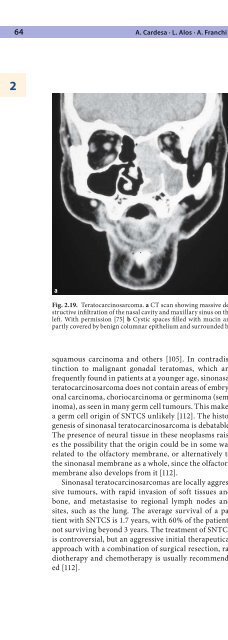Pathology of the Head and Neck
Pathology of the Head and Neck
Pathology of the Head and Neck
- No tags were found...
You also want an ePaper? Increase the reach of your titles
YUMPU automatically turns print PDFs into web optimized ePapers that Google loves.
64 A. Cardesa · L. Alos · A. Franchi2baFig. 2.19. Teratocarcinosarcoma. a CT scan showing massive destructiveinfiltration <strong>of</strong> <strong>the</strong> nasal cavity <strong>and</strong> maxillary sinus on <strong>the</strong>left. With permission [75] b Cystic spaces filled with mucin arepartly covered by benign columnar epi<strong>the</strong>lium <strong>and</strong> surrounded bycimmature blastematous tissue. c Immature gl<strong>and</strong>s surrounded byblastematous elements at <strong>the</strong> lower left; presence <strong>of</strong> immature striatedmuscle, upper right <strong>and</strong> centresquamous carcinoma <strong>and</strong> o<strong>the</strong>rs [105]. In contradistinctionto malignant gonadal teratomas, which arefrequently found in patients at a younger age, sinonasalteratocarcinosarcoma does not contain areas <strong>of</strong> embryonalcarcinoma, choriocarcinoma or germinoma (seminoma),as seen in many germ cell tumours. This makesa germ cell origin <strong>of</strong> SNTCS unlikely [112]. The histogenesis<strong>of</strong> sinonasal teratocarcinosarcoma is debatable.The presence <strong>of</strong> neural tissue in <strong>the</strong>se neoplasms raises<strong>the</strong> possibility that <strong>the</strong> origin could be in some wayrelated to <strong>the</strong> olfactory membrane, or alternatively to<strong>the</strong> sinonasal membrane as a whole, since <strong>the</strong> olfactorymembrane also develops from it [112].Sinonasal teratocarcinosarcomas are locally aggressivetumours, with rapid invasion <strong>of</strong> s<strong>of</strong>t tissues <strong>and</strong>bone, <strong>and</strong> metastasise to regional lymph nodes <strong>and</strong>sites, such as <strong>the</strong> lung. The average survival <strong>of</strong> a patientwith SNTCS is 1.7 years, with 60% <strong>of</strong> <strong>the</strong> patientsnot surviving beyond 3 years. The treatment <strong>of</strong> SNTCSis controversial, but an aggressive initial <strong>the</strong>rapeuticalapproach with a combination <strong>of</strong> surgical resection, radio<strong>the</strong>rapy<strong>and</strong> chemo<strong>the</strong>rapy is usually recommended[112].References1. Abdel-Latif SM, Baheeg SS, Aglan YI, Babin RW, Giltman LI(1987) Chronic atrophic rhinitis with fetor (ozena): a histopathologictreatise. Rhinology 25:117–1202. Abemayor E, Canalis RF, Greenberg P, Wortham DG, Rowl<strong>and</strong>JP, Sun NC (1988) Plasma cell tumors <strong>of</strong> <strong>the</strong> head <strong>and</strong>neck. J Otolaryngol 17:376–3813. Abbondanzo SL, Wenig BM (1995) Non-Hodgkin’s lymphoma<strong>of</strong> <strong>the</strong> sinonasal tract. A clinicopathologic <strong>and</strong> immunophenotypicstudy <strong>of</strong> 124 cases. Cancer 75:1281–12914. Acheson ED, Cowdell RH, Hadfield E, Macbeth RG (1968)Nasal cancer in woodworkers in <strong>the</strong> furniture industry. BrMed J 2:587–5965. Acheson ED, Cowdell RH, Jolles B (1970) Nasal cancer in <strong>the</strong>Northamptonshire boot <strong>and</strong> shoe industry. Br Med J 1:385–3936. Aguilera NS, Kapadia SB, Nalesnik MA, Swerdlow SH (1995)Extramedullary plasmacytoma <strong>of</strong> <strong>the</strong> head <strong>and</strong> neck: use <strong>of</strong>paraffin sections to assess clonality with in situ hybridization,growth fraction, <strong>and</strong> <strong>the</strong> presence <strong>of</strong> Epstein-Barr virus.Mod Pathol 8:503–5087. Aktas D, Yetiser S, Gerek M, Kurnaz A, Can C, KahramanyolM (1998) Antrochoanal polyps: analysis <strong>of</strong> 16 cases. Rhinology36:81–858. Alobid I, Alos L, Blanch JL, Benitez P, Bernal-Sprekelsen M,Mullol J (2003) Solitary fibrous tumour <strong>of</strong> <strong>the</strong> nasal cavity<strong>and</strong> paranasal sinuses. Acta Otolaryngol 123:71–749. Alos L, Cardesa A, Bombí JA, Mall<strong>of</strong>ré C, Cuchi A, TraserraJ (1996) Myoepi<strong>the</strong>lial tumours <strong>of</strong> salivary gl<strong>and</strong>s: a clinico-








